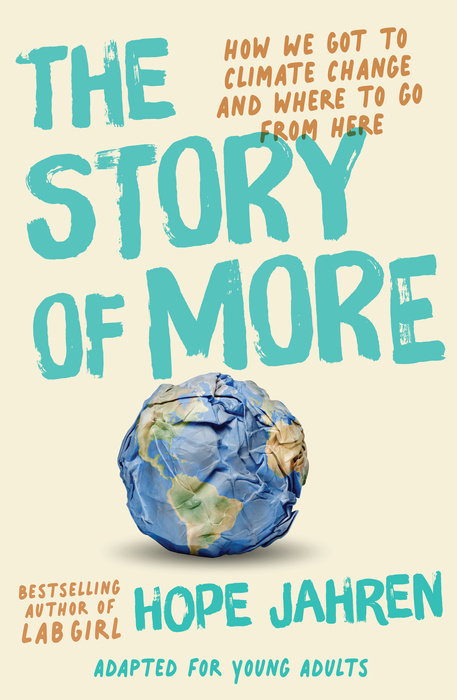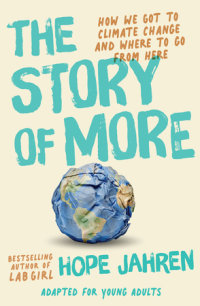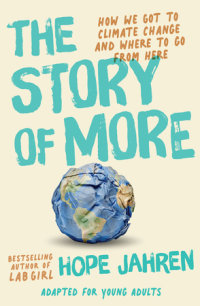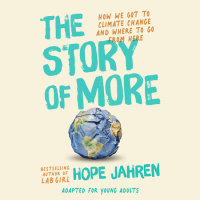The Story of More (Adapted for Young Adults)
This young adult adaptation of acclaimed geochemist and geobiologist Hope Jahren's highly respected nonfiction work is the perfect book for those interested in learning about climate change and how they can contribute to creating a more sustainable future.
Hope Jahren illuminates the science behind key inventions, clarifying how electricity, large-scale farming, and automobiles have both helped and harmed our world. She explains the current and projected consequences of unchecked global warming, from superstorms to rising sea levels, resulting from the unprecedented amounts of greenhouse gases being released into our atmosphere.
The links between human consumption habits and our endangered existence are very real. Still, Jahren maintains that our ever-broadening science-based knowledge can help us counter these effects. The eye-opening information in The Story of More will help readers understand the path needed. If we collectively make informed choices now, Jahren reassures, our future can be as bright as we imagine it can be.
An Excerpt fromThe Story of More (Adapted for Young Adults)
1
Our Story Begins
The sun and solar energy. What a source of power! I hope we don’t have to wait until oil and coal run out before we tackle that.
—Thomas Edison to Henry Ford and Harvey Firestone (1931)
You have probably been hearing about climate change your whole life. Maybe you’ve seen it on the news, or seen movies about it, or read about it in school, or heard people debating about it in your home. You’ve probably heard people ask if climate change is real. Is it something we should be afraid of? When will it happen and how bad will it be? You may have heard it called a “hoax.” You may have heard it called “the biggest challenge your generation will ever face.” You might even be sick of hearing about it altogether.
You know what? I get it. I’m more than fifty years old, and I’ve been hearing people argue over climate change for at least twenty years. I am a scientist who studies climate change, and so—lucky me—I get to hear people argue about it almost every day. But lately I learned that the arguments go back much further than that.
In 1969, more than half a century ago, the Norwegian explorer Bernt Balchen noticed a thinning trend in the ice that covered the North Pole. He warned his colleagues that the Arctic Ocean was melting into an open sea. The New York Times picked up the story, and Walter Wittmann of the US Navy immediately disagreed: he had seen no evidence of thinning during his monthly airplane flights over the pole.
But that’s not nearly all: in 1931, Thomas Edison said to Henry Ford and Harvey Firestone, “The sun and solar energy. What a source of power! I hope we don’t have to wait until oil and coal run out before we tackle that.” That’s right—the guy who invented the light bulb (Edison) urged renewable energy on the guy who invented the car (Ford) and the guy who invented the tire (Firestone). Almost one hundred years ago these important men were talking about “green energy,” while at the very same time, they were initiating our modern addiction to fossil fuels.
Let’s go back to 1969 for a moment, back when Balchen was fighting with Wittmann. I don’t remember 1969 personally, but, like every year, it was full of beginnings and endings, problems and solutions, equal to any that had gone before or have come since.
Most of the trees you see out your window were barely seeds in 1969. Wal-Mart Stores, Inc., was incorporated in 1969 and has since become the world’s largest private employer. Sesame Street premiered in 1969 and went on to teach millions of children how to count and spell. Big things started out as small things, then grew to change the world.
Way up north, in Mower County, Minnesota, my parents weren’t paying attention, for I was one of the ten million babies born on September 27, 1969, and the last of their four children. The world would be different for this baby, my parents promised each other, and they made the ancient vow that all mothers and fathers make in the euphoria that follows a happy birth.
I would have all the love that my father could give and all the love that my mother should have been given. She will grow up free, my mother resolved—free from hunger and from the shame of being taken by the county. My father, for his part, looked forward to a century of technologies that would save us all from sickness and want. Like the millions of couples who had come before them, and would come after, they looked at the world they lived in and thought about the one they wanted. Then my parents turned to each other, in love, and they named me Hope.
Forty years later, in 2009, my department chair called me into his office and asked me to teach a class on climate change. I’ll admit that, at first, I was not excited about the idea. Convincing people to lower their energy use is like trying to get them to quit smoking or to eat more healthfully: they already suspect they should do it, but there’s a billion-dollar industry working round the clock, inventing new ways to make sure they don’t. I would start, I conceded, by taking my boss’s orders at face value. I sat down at my desk, turned on my computer, and began to research change. Over the next several years, I cataloged the data that describes how population has increased, how agriculture has intensified, how energy use has skyrocketed over the last half century. I accessed public databases and downloaded files of numbers and spreadsheets. I searched through the data for patterns across the decades of my own life. I set out to quantify global change in the most concrete and precise terms that I could apprehend, and I learned a lot by doing it.
This research became the foundation of a course I taught many times. Each week during the semester, I’d pick up the chalk and teach a room full of students the numbers describing how planet Earth had changed since I was a kid back in the 1970s. I taught them what has happened. Not what I think might happen. Not what I think should happen. I taught them the things that I had taught myself. And as I did my job, I finally began to understand why I was doing it: because only after we see where we are can we duly ask ourselves if this is where we want to be. At the bottom of it all, I had learned, we have only four resources: the earth, the ocean, the sky, and each other.
All of this has convinced me that it’s time to bring global change out of my classroom and into this book. Not because I am a scientist who thinks she’s right, but because I am an author who loves both words and numbers, and a teacher who has something to say.
So if you’ll listen, I’ll tell you what happened to my world, to your world—to our world. It changed.
2
Who We Are
Four thousand years ago, the people living along the Tigris-Euphrates River valley in a place they called Mesopotamia, were deeply worried that planet Earth could never provide enough food, water, shelter, and space for the population they saw increasing all around them. Their poets wrote about “the countless tribes of men” who “oppressed the surface of the deep-bosomed Earth.” These poems were written in about 1800 BC, just as world population hit somewhere near one hundred million people. During the one thousand years that followed, global population doubled.
The famous Greek philosopher Aristotle believed that politicians should decide “of what numbers and of what sort of people” a country should contain because, according to him, “too large a multitude are incapable” of keeping themselves in good order. If people would just follow his directions, Aristotle insisted, the population would be appropriately curbed, and Earth would forever be able to supply its inhabitants with the “necessaries of life.” He wrote these things over two thousand years ago, just as world population was nearing 250 million. During the one thousand years that followed, global population doubled again.
A priest named Suger spent much of his life raising funds to renovate his church entrance, which was so crowded that it “forced women to run to the altar on the heads of men as on a pavement” due to the population explosion of the High Middle Ages. Suger wrote this nine hundred years ago, when the world population was about one-half billion people. Within the next five hundred years, global population doubled yet again.
Thomas Robert Malthus made people really nervous in 1798, when he wrote An Essay on the Principle of Population. Any and every improvement in food production, he argued, would give rise to an increase in population that would, in turn, reestablish a state of want. Malthus believed that our planet writhes within an everlasting state of overpopulation and that every bite we put into our mouths makes things worse. When he published his essay, the world’s population was approaching one billion, and during the one hundred years that followed, global population doubled again.
Fifty years later, a man named John Stuart Mill expanded Malthus’s argument to include the broader economic “penalty attached to over-population.” He spelled out his idea this way: “A greater number of people can not, in any given state of civilization, be collectively so well provided for as a smaller.” John Stuart Mill insisted these things during 1848, just as world population approached 1.5 billion people. And within the next century, the global population doubled again.
There was another man who saw things differently: an American economist named Henry George. He believed in a hopeful feedback loop between human population and food production: “Give more food, open fuller conditions of life, and the vegetable or animal can but multiply; the man will develop.”
Henry George was a humble and pious man; he had known poverty and lived modestly even after success. He was ahead of his time in many ways, advocating for public transportation, labor unions, and a half-female Congress during the nineteenth century, but the public loved him. More than a hundred thousand mourners attended his funeral after he died in 1897. It also turns out that Henry George, out of all those important men who came before him, was the one who came closest to being right about population growth.
The doubling of global population that has occurred since the time of Henry George was accompanied by a tripling of grain production, a tripling in fish production, and a quadrupling in meat production. The arrival of more people has indeed coincided with greater food production, just as Henry George believed it would—far above and beyond what was strictly required.
Henry George was also right in that most of the want and suffering we see in our world today originates not from Earth’s inability to provide but from our inability to share, as we’ll see so many times in later pages. It is because so many of us consume far beyond our needs that a great many more of us are left with almost nothing.
And what about now? What about us? As for me, I was born just over fifty years ago, in 1969, adding one small female to what was then a world population of 3.5 billion people. Between then and now—that is, over the course of my lifetime so far—the global population has doubled yet again.
Today, you and I share the world with more than seven billion people.
This means that, unless some terrible sickness or war devastates not just countries but whole continents, our earth will never again contain fewer than seven billion people. We must learn to live together if we want to live well. How can we do this?
Ultimately, we are endowed with only four resources: the earth, the ocean, the sky, and each other.
Because absolutely everything is at stake, we should begin by thinking clearly and simply. Let’s begin where every human story begins. We’ll begin with a baby.




